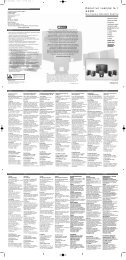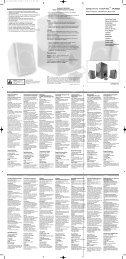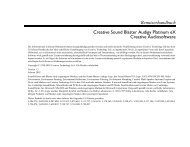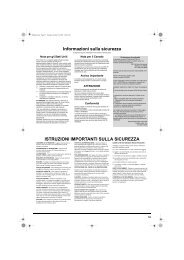E-MU 0404 PCIe Digital Audio System OpMan - English - Version 2.10
E-MU 0404 PCIe Digital Audio System OpMan - English - Version 2.10
E-MU 0404 PCIe Digital Audio System OpMan - English - Version 2.10
Create successful ePaper yourself
Turn your PDF publications into a flip-book with our unique Google optimized e-Paper software.
4 - The PatchMix DSP Mixer<br />
The Session<br />
The Session<br />
The current state of the PatchMix DSP mixer (fader settings, effects routings…everything!) can<br />
be saved as a Session. Whenever you create or modify a mixer setup, all you have to do is Save<br />
it to be able to recall it at a later time.<br />
Before you begin using PatchMix DSP, you need to set it up to be compatible with the other<br />
software applications you may be running. The most important consideration is your system<br />
sample rate. PatchMix DSP and any applications or other digital gear you are using must<br />
be set to the same sample rate. PatchMix DSP can run at 44.1kHz, 48kHz, 88.2kHz, 96kHz,<br />
176.4 kHz or 192kHz sample rates, but the effect processors are only available at the 44.1kHz<br />
or 48kHz rates.<br />
When you start a new PatchMix DSP Session, the first choice you make is to select the sample<br />
rate. Once set, you can only easily switch between 44.1kHz and 48kHz. You cannot switch<br />
between 44/48kHz and 88k/96k/176k/192k. With a change to these higher sample rates,<br />
you must start a new session.<br />
You can also set up an external sync source, thereby obtaining the sample rate from some other<br />
device or application. External sync can be obtained from the S/PDIF input. If the session is set<br />
at 44.1kHz or 48kHz and the external source is coming in at 96kHz, the Sync Indicator will be<br />
extinguished (off), but PatchMix will attempt to receive the external data. if the Sync Indicator<br />
is Off, the two units are NOT sample locked and you should correct this condition to avoid<br />
intermittent clicks in the audio. Always check for the presence of the “LOCKED” indicator<br />
whenever you are using a digital interface.<br />
PatchMix DSP comes with several session templates to choose from so when you create a new<br />
session you can either create a “blank” session based around a designated sample rate, or select<br />
from a list of template starting points.<br />
In a PatchMix DSP session the number of strips in the mixer is dynamically configurable. See<br />
Pre Fader or Post Fader. This allows you to create only those strips you need up to a maximum<br />
number determined by available DSP resources and available inputs.<br />
Important: When<br />
using any form of digital<br />
input, you <strong>MU</strong>ST<br />
synchronize the <strong>Digital</strong><br />
<strong>Audio</strong> <strong>System</strong> to the<br />
external digital device.<br />
See Using External Clock<br />
New Session<br />
You create a new session by clicking the “New Session” button in the PatchMix DSP main<br />
Toolbar. The following dialog box appears.<br />
Select a Template or new<br />
Session at the desired<br />
sample rate<br />
Session Description<br />
Add your own comment<br />
or note about the Session<br />
Check this if you want to<br />
edit the New Session.<br />
20 Creative Professional






